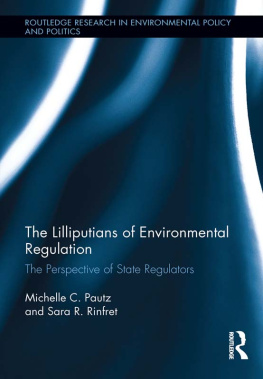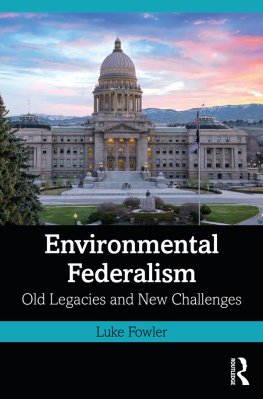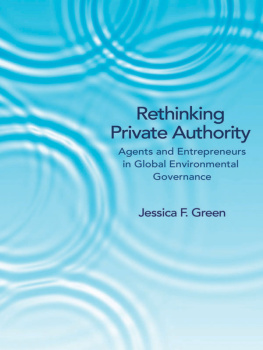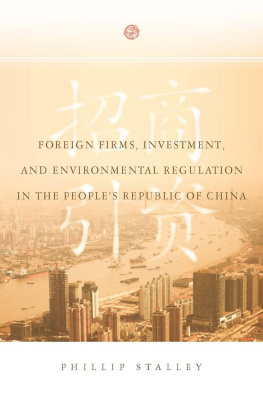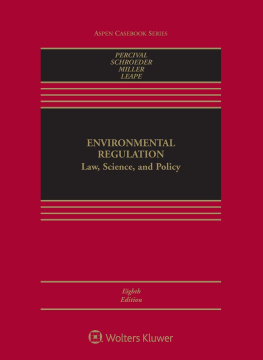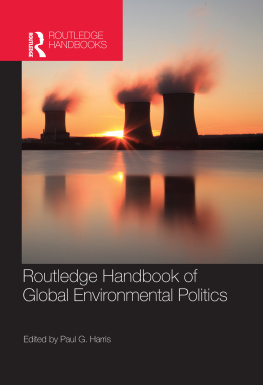In this extensively researched and engaging book, Pautz and Rinfret dispel a number of myths about the front lines of state-level environmental regulation in the United States. The findings underscore the potential for and value of a partnership between regulators and regulatees in bringing about compliance. The book should be read by those who are concerned with improving the implementation of environmental regulations.
Peter J. May, University of Washington
Environmental regulation today is widely criticized for many alleged failings without much understanding of how the system of federal and state policy implementation actually works, and whether proposed alternatives to regulation would do any better. This unique volume contributes significantly to our understanding of environmental policy by offering extensive new data on and many new insights into a critical but neglected component of the regulatory systemthe work of front-line professionals at state agencies, the Lilliputians, whose daily and often positive interaction with the targets of regulation is critical to its success.
Michael E. Kraft, University of Wisconsin-Green Bay
The Lilliputians of Environmental Regulation
When we think about environmental policy and regulation in the U.S., our attention invariably falls on the federal level and, more specifically, the U.S. Environmental Protection Agency. Although such a focus is understandable, it neglects the actors most responsible for the implementation and maintenance of the nation's environmental lawsthe states. Recognition of the importance of the states still ignores an even smaller subsection of actors, inspectors. These front-line actors in state environmental agencies are the individuals responsible for writing environmental rules and ensuring compliance with those rules. They play an important role in the environmental regulatory state.
With data collected from more than 1,200 inspectors across 17 states, Michelle C. Pautz and Sara R. Rinfret take a closer look at these neglected actors to better understand how environmental regulators perceive the regulated community and how they characterize their interactions with them. In doing so, they explore the role these front-line actors play, what it is like to be them, what they think of their place in the environmental regulatory system, and how they interact with the regulated community.
An original, timely and unmatched volume advancing the debate on the future of environmental regulation in the U.S.
Michelle C. Pautz is an assistant professor of political science at the University of Dayton where she teaches undergraduate and graduate courses in public administration, environmental policy, and public policy. Her work has been published in Administration & Society, Administrative Theory & Praxis, Journal of Environmental Studies & Sciences, Policy Studies Journal, PS: Political Science & Politics, and Review of Policy Research, among others.
Sara R. Rinfret is an assistant professor of political science at Hartwick College. She teaches undergraduate courses in regulatory policy, public policy, public administration, and environmental policy. Her work has been published in Society and Natural Resources, Environmental Politics, Review of Policy Research, PS: Political Science & Politics, Oxford Handbook of U.S. Environmental Policy, and Human Dimensions of Wildlife, among others.
Routledge Research in Environmental Policy and Politics
Green vs. Green
The Political, Legal, and Administrative Pitfalls Facing Green Energy Production
Ryan M. Yonk, Randy T. Simmons, and Brian C. Steed
The Lilliputians of Environmental Regulation
The Perspective of State Regulators
Michelle C. Pautz and Sara R. Rinfret
The Lilliputians of Environmental Regulation
The Perspective of State Regulators
Michelle C. Pautz
University of Dayton
and
Sara R. Rinfret
Hartwick College
First published 2013
by Routledge
711 Third Avenue, New York, NY 10017
Simultaneously published in the UK
by Routledge
2 Park Square, Milton Park, Abingdon, Oxon OX14 4RN
Routledge is an imprint of the Taylor & Francis Group, an informa business
2013 Taylor & Francis
The right of Michelle C. Pautz and Sara R. Rinfret to be identified as author of this work has been asserted by them in accordance with sections 77 and 78 of the Copyright, Designs and Patents Act 1988.
All rights reserved. No part of this book may be reprinted or reproduced or utilised in any form or by any electronic, mechanical, or other means, now known or hereafter invented, including photocopying and recording, or in any information storage or retrieval system, without permission in writing from the publishers.
Trademark Notice: Product or corporate names may be trademarks or registered trademarks, and are used only for identification and explanation without intent to infringe.
Library of Congress Cataloging in Publication Data
Pautz, Michelle C.
The Lilliputians of environmental regulation : the perspective of state regulators / Michelle C. Pautz, Sara R. Rinfret.
p. cm.(Routledge research in environmental policy and politics; 2)
1. PollutionGovernment policyUnited StatesStates.
2. Environmental policyUnited StatesStates. 3. Environmental protectionUnited StatesStates. I. Rinfret, Sara R. II. Title.
HC110.P55P38 2012
363.7dc23
2012024562
Typeset in Sabon
by Apex CoVantage, LLC
Permissions Acknowledgments
Next-Generation Environmental Policy and the Implications for Environmental Inspectors: Are Fears of Regulatory Capture Warranted? by Michelle C. Pautz Environmental Practice, Volume 12, Issue 03 (2010), pp. 247259. Copyright 2010 National Association of Environmental Professionals. Reprinted with the permission of Cambridge University Press.
To Brenda, Harold, Laurel, and all the Lilliputians.
Contents
Tables
Figures
Preface
The idea for this book began many years ago when one of us (Michelle Pautz) was an intern with the Virginia Department of Environmental Quality (DEQ). While at DEQ, she was tasked with reading federal Maximum Available Control Technology standards and providing inspectors guides to these standards. Reading these regulations proved far more challenging than she thought, and her simplistic notion that compliance assessment was straightforward was shattered.
Over the course of her time with the agency, her perspective on environmental regulation evolved tremendously as a result of working with inspectors. She came to realize that environmental police, complete with flashing lights and badges, is not what protects the environment. Nor is environmental protection achieved through the work of corporations, large and small. Instead, environmental protection is accomplished when the seemingly opposing sides of environmental regulationthe regulator and the regulatedwork together to achieve environmental protection. And she had the opportunity to witness that cooperation firsthand. This complexity and evolution in perceptions about the environmental regulatory state are at the heart of our work.
This book project began in earnest when we happened to find ourselves on a panel together presenting research about the unsung heroes of environmental regulation at the 2010 Midwest Political Science conference in Chicago, Illinois. Together, we realized that our research and previous experiences in the public sector emphasized those often-unnoticed environmental regulators. At the time, the political landscape was changing due to the 2010 midterm elections, and the war on regulation resurfaced. For us, the time was ripe to combine our research interests and knowledge to document the often-overlooked voices of state environmental regulators.

